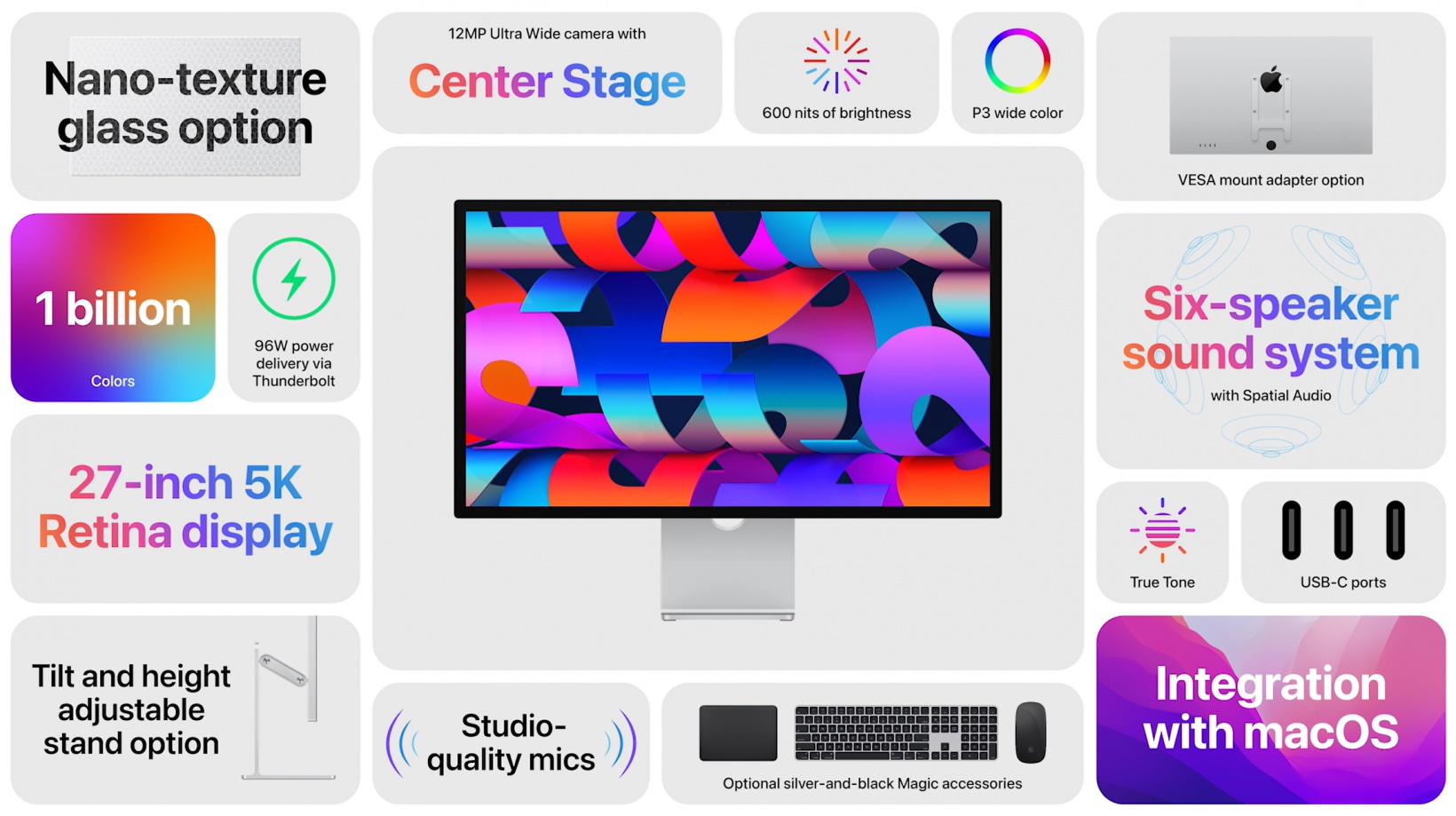
It’s been almost a week and I’m still thinking about Apple’s Studio Display.
This isn’t because I adore it (although I do), it’s because I’ve seen the light and I know what the company needs to do: release a $500 monitor called the Apple Display.
I can feel you salivating at the thought of that.
Before we get into the specifics, let’s backtrack and talk about Apple’s just-released Studio Display — because it’s probably the most sensual I’ve felt towards a monitor since I first moved from CRT to LCD.
Announced last Tuesday, the Studio Display is a 27-inch 5K monitor. So far, so standard, but where it deviates from other, more regular displays is with what else Apple has jammed in.
Firstly, it has six speakers. And, considering the audio quality on the new iMacs and MacBook Pros, this’ll give the monitor some of the finest sound in its category.
Secondly, Apple has integrated the A13 Bionic chip into the Studio Display. This is the same hardware that powered the iPhone 11 Pro and ninth-generation iPad.
In other words, it’s a serious bit of kit. With a lot of potential too.
Although Apple has only confirmed it’s using it for features like Center Stage and Siri, technically, the A13 chipset could run a full operating system on the monitor.
While we’re here, let’s take a short, leisurely stroll down this thought avenue.
How the Apple Studio display could change how we think about monitors

There’s a chance that, in the future, Apple plans to turn the Studio Display into something more than a monitor.
For example, the latest Apple TV (that’s the 4K) has an inferior chipset to what’s nestled inside the company’s newest screen. This means it’s possible the company could roll out a version of tvOS that works on the monitor.
One way this could work is using the memory, storage, and Wi-Fi of the connected computer. Another, more exciting, method is Apple releases a USB-C dongle that plugs into the back of the Studio Display to support it operating as a standalone media player.
An Apple Stick, if you will. Of course, there’s no evidence for this — but it’s an interesting thought experiment.
In this vein, there’s also the question of whether Apple will eventually enable connected machines to use the A13 Bionic embedded in the Studio Display.
The chipset is capable of one trillion operations per second — and this would be an excellent extra resource to pull on if you’re undergoing intensive tasks. If this is possible, Apple may have quietly altered what we expect from our monitors.
What’s wrong with the Studio Display

Anyway, we’re getting away from the crux of this article, which is effectively me begging Apple to do what I want it to.
For me, the biggest downside of the Studio Display is its price. At $1,599, Apple’s new monitor is eye-wateringly expensive.
Look, I’m not one of these people who bemoans paying for Apple’s premium products. If you’re a graphic designer or in a similar field, then the Studio Display could well be worth it — especially when combined with the Mac Studio.
Thing is, I’m not. So spending that much cash on an external monitor would be pure folly.
That’s why Apple should release a lower-end display for people like me. And, in my optimistic mind, it should be around $500.
What would this cheaper display look like?
My starting point for this request is simple: the new 24-inch iMac.
The basic model for the whole computer starts off at $1,299. That includes an M1 chip, 8GB of unified memory, 256GB storage, a keyboard and a 4.5K Retina display.
What I’m saying is rip out the chips and memory, and just sell me the damn screen. Apple could even drop it down to a 21-inch display to save cash and I’d still be excited.

At this stage, I can probably guess what a lot of you are screaming at the screen: “Why do you need an Apple monitor, Callum? You can get an excellent display with higher specs for less than $500.”
And you’re totally right.
Something like the Dell S3220DGF has a curved 32-inch screen, 1440p resolution, 165Hz refresh rate (compared to 60Hz on the Studio Display), HDR, and a whole lot more.
Oh! And it retails for $399.
Logically, buying this Dell monitor makes sense — but since when was following Apple about cold, hard logic? Long story short, I’d happily pay the ‘Apple Tax’ for an external display that’s aesthetically pleasing and, maybe, works a smidgen better with my Apple devices than third-party models.
Plus, if Apple sells something like what I’ve described above for around $500, it’s going to be a success. In other words, give me the Apple Display and take my money.
Why Apple won’t release a $500 external display any time soon
Remember when people were up-in-arms about Apple’s $5,000 Pro XDR display and its $1,000 stand? One of the elements I thought many commentators missed is these products were never aimed at people.
What I mean by that is Apple’s goal was never selling these devices to people who want a nice screen. Instead, they were aimed at businesses.
From around 2014, the company has focused on making its computing products attractive to the enterprise. And, in many ways, it has succeeded.
While it’s unlikely swathes of people working in traditional finance will be using MacBooks, Apple has an incredibly strong foothold in the creative industries. Every job I’ve had in the past decade used the company’s computers — and they appear to have become the de facto choice for the advertising, marketing, design, and web development sectors.
Industry is where the money is, and Apple knows it.
I’d posit the majority of sales for the Pro XDR, the Mac Studio, and Studio Display will be made by companies or, at the very least, freelancers.
And what does this mean? Tax breaks and people willing to spend more money for the best. Time matters in these sectors — and it’s especially pertinent that these purchases can be written off as business expenses, rather than personal ones.
With this in mind, why rush out a cheaper display?
Yes, there’s no doubt the company could make a killing selling its $500 Apple Display monitors — but it’s undoubtedly going to make a higher profit margin pushing the Studio Display instead.
Hell, it can even use the adoption of its new monitor as a barometer for whether there’s public hunger for the lower-end Apple Display. Which — and let me say this as clearly and loudly as I can — there is.
Unfortunately, this leaves me waiting. Lonesome. Howling at the moon. As much as I want the Studio Display, there’s no way I can warrant spending that much on it. Honestly? I’d rather pay for an iMac instead.
Still, I live in hope. And if Apple did ever get its ass into gear and released the standard Apple Display? Damn, you know I’d be waiting right outside that store days before it dropped.
(Update, 15th March: An earlier version of this piece said the the Dell S3220DGF has a 4K resolution, when it has a 1440p screen instead. The article has been updated to reflect that).
Get the TNW newsletter
Get the most important tech news in your inbox each week.





